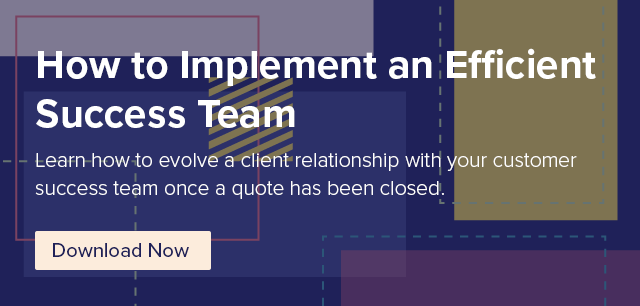Top 5 Customer Success Metrics You Need to Track to Grow Your Business

We’re all familiar with the old question “If a tree falls in the woods, but no one is there to hear it, does it make a sound?” What this question really asks is if there’s an action, but no one monitoring it and no way to measure it (via sound), how do we know it happened? While on a philosophical front, this question asks us to look deeply at what it means to observe, but it’s also asking about metrics or measurements.
How we gauge what is happening across any landscape, whether forest or business, means we have to be looking at metrics and measurements. This is especially true in the customer success sphere. Because the concept of customer success vs. customer service/support is to be proactive, it means those responsible for ensuring the success of customer initiatives must be actively monitoring customer success metrics; they must be in the forest to hear the tree fall.
Quick Links
- What is customer success?
- Why is customer success important?
- What customer success metrics should you be tracking?
- Reporting/tracking customer success KPIs
- How BrightGauge dashboards can help you monitor customer success
What is customer success?
Customer success is a way of reframing the traditional service aspect of customer relationship management. As discussed in our blog on customer success teams, the language suggests a shift in the way businesses, particularly those that provide services, view their goals in relation to their customers' goals.
In other words, rather than looking at what we can do for our clients and customers, we look at what we can do with them. By partnering our success with theirs, we ensure not only that both of our goals are achieved, but are done so through the strength and reliability of not just our service but also our relationship.
Customer success means understanding that when your clients are successful, you will be too.
Why is customer success important?
The key to business success lies with your customers. If they’re successful, and your services help deliver those wins, they’ll stick with you. And, if you’re looking to grow your business and looking at where the revenue is (and how customer retention is less costly than acquisition) it’s in both up-selling and cross-selling to your existing customers.
Additionally, happy customers are more likely to spread positive word of mouth which wins you even more business without investing marketing money. Simply put, success for your customers is success for you.
That’s just the bottom line. It’s important to look beyond that as well. While all of the factors impact that bottom line, in many ways business success is connected to relationship management. There are few better ways to create lasting relationships than by investing in someone else’s success. It fosters trust and creates value for your customers. In turn, they’re more likely to be open to more services or products and more likely to recommend your business.
While it all circles back around to increasing revenue and growth for your business, one cannot undervalue the connection this relationship strategy creates between you and your customers.
What customer success metrics should you be tracking?
If customer success is so closely tied to your own success or growth, then tracking customer success metrics is vital. As with any business data, these metrics can reveal a lot about the health of your organization and about your customer success initiatives.
1. Customer churn
The first metric you’ll want to pay attention to is churn or the rate at which customers leave. While some attrition is normal, you’ll want to, first, establish whether you want to gauge this rate monthly or yearly. Then, you can determine your churn rate by dividing total customers by those who have left. Keeping an eye on this number is vital as customers who are successful, who find value in your services, don’t leave. Any uptick here, especially a significant one, merits investigation and response.
2. Expansion revenue
If revenue is income, expansion revenue is the amount of that income that comes from existing customers. If you have been able to expand the goods or services they’re purchasing from you, it’s a pretty good indicator that you’re on the right track. As noted above, happy customers are amenable to up-selling and cross-selling and so this metric is a good measure of your customer’s success rate both with your services and with their goals.
3. Customer satisfaction
Customer satisfaction is a metric you should be gauging through surveys as well as through qualitative measures such as conversations, reviews, and more. Numbers, like churn and revenue, are great measurements, but they don’t take the place of talking to customers to learn how they’re feeling. In fact, churn and revenue will provide the end result, but once you’ve got those numbers, it’s too late. In contrast, monitoring customer satisfaction can let you know of and respond to issues before the customer takes action, or before they leave.
4. Net Promoter Score (NPS)
Especially crucial for service providers, the net promoter score reveals how likely existing customers are to suggest or recommend your service to others. NPS is fairly easy to gauge by simply asking how likely a customer is to recommend you. While asking is fairly easy, this simple score is indicative of much more. For example, businesses with higher NPS scores than competitors outgrow them by twice as much. Further, customers who report high NPS scores have an average lifetime customer value 3-8 times higher than other customers.
In short, NPS is a great way to measure customer health. These customers are loyal, more likely to spend with you, and more likely to suggest your business to other potential customers. In terms of value, this can’t be beat.
5. Customer Lifetime Value (CLV)
Customer lifetime value is also a good customer success metric to be focusing on. As with other metrics, one number reveals far more.
CLV estimates the value of a customer, how much they will spend, during their relationship with you. To measure customer lifetime value, you’ll want to divide the average revenue per account by customer churn rate. Once you have your CLV, you can then start gauging how much you should spend on acquisition which is an important metric to understand as well.
However, in terms of customer success metrics, your CLV should be growing rather than shrinking. Growth in this number indicates that customers are staying with you longer or purchasing more services/upgrading. In contrast, if the number is shrinking, it’s time to examine whether your customer churn rate is growing as well or investigate the value of your services. Growth here suggests your customers see value in your services, enough to continue to invest.
As with customer success itself, customer success metrics require proactive monitoring. This stands in contrast to customer service which is typically responsive. When the client comes to you, you respond. Customer success, on the other hand, looks at all the metrics, from the ones listed above, to those codified on an SLA (service level agreement) and more and insists on action before the customer voices concerns.
Reporting and tracking customer success metrics
Now that we’ve identified the top customer success metrics you should be monitoring, it’s essential to know what you should be monitoring for. One of the advantages to using business intelligence tools is the ability to see these metrics with a visual representation, such as a gauge, but we’ll get to that in a bit.
The key piece, however, is that you are both tracking and reporting these metrics to the folks who need to know. For your customers, that means you’ll need to be providing quarterly business reviews to provide information on SLA metrics such as response times and ticket times.
For your team, you still need to be reporting and ensuring that the key customer success metrics are falling within your desired range. Early on, that may be based on industry standards, but as you perfect your strategies, you may want to include those metrics in longer term organizational goals.
These numbers may differ based on your industry or the historical performance of your specific company, but most industry guidelines say you should consider:
- A customer churn rate of no more than 5%.
- Expansion revenue should be 20-30% (minimum) of your business revenue
- A customer satisfaction score of 50 is average, but it really depends on your industry and, as always, aim higher.
- A net promoter score again depends on industry, but 60 is average across multiple verticals.
- Customer lifetime value will have to be calculated differently based on multiple business variables, but there’s a great overview here that will allow you to assess all of the factors that go into that number.
Understanding the baseline and industry standards for these scores is a good place to start your tracking, but understanding how your business is performing is even more essential. That’s why using dashboards is a great way to stay on top of metrics.
How BrightGauge dashboards can help you monitor customer success
One of the biggest benefits of business intelligence tools is their ability to put all the data and information you need at your fingertips. In fact, using dashboards and gauges enables you to see, on one screen, in one location, without complex coding or manually consolidating data, all the metrics you’re trying to track for different teams, initiatives, or even individual employees.
BrightGauge’s tools allow you to customize your dashboards and automate reports. That means you can share your dashboard with your customer success team and regularly keep your customers informed about the services you’re providing.
Remember, customer success is about providing proactive solutions and being responsive rather than reactive. If you’re ready to explore how BrightGauge’s tools can help your team embrace customer success as a strategy, get in touch with our team today!
Free MSA Template
Whether you’re planning your first managed services agreement, or you’re ready to overhaul your existing version, we've got you covered!


